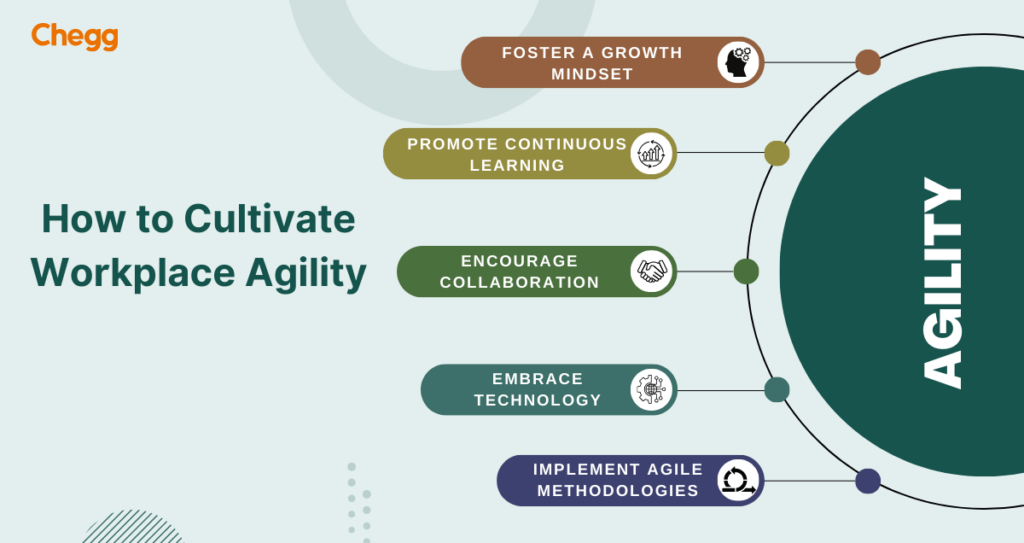How to Navigate Change and Uncertainty with Workplace Agility?
In today’s dynamic business landscape, workplace agility is more than just a competitive advantage, it’s a necessity. Agility in the workplace enables individuals and teams to adapt quickly to changes, innovate continuously, and maintain high-performance levels. This blog will delve into the concept of workplace agility, its importance, and actionable strategies to cultivate it within […] The post How to Navigate Change and Uncertainty with Workplace Agility? appeared first on Chegg India.

In today’s dynamic business landscape, workplace agility is more than just a competitive advantage, it’s a necessity. Agility in the workplace enables individuals and teams to adapt quickly to changes, innovate continuously, and maintain high-performance levels. This blog will delve into the concept of workplace agility, its importance, and actionable strategies to cultivate it within your professional environment.
What is Workplace Agility?
Workplace agility refers to the ability of employees and organizations to respond swiftly and effectively to changes in the market, technology, and internal processes. It involves a combination of adaptability, flexibility, and a proactive mindset. Agile workplaces are characterized by their ability to pivot strategies, embrace new technologies, and foster a culture of continuous improvement.
The Importance of Workplace Agility
- Enhanced Adaptability: Agile workplaces can quickly adjust to market shifts, technological advancements, and evolving customer needs.
- Increased Innovation: It encourages a culture of innovation, where employees feel empowered to experiment and implement new ideas.
- Improved Productivity: Agile teams can streamline processes, reduce inefficiencies, and focus on high-impact activities.
- Greater Employee Engagement: An agile work environment fosters collaboration, autonomy, and a sense of purpose, leading to higher employee satisfaction and retention.
How to Cultivate Workplace Agility

1. Foster a Growth Mindset
Encourage employees to adopt a growth mindset, where they view challenges as opportunities to learn and grow. This mindset is crucial for embracing change and driving innovation.
2. Promote Continuous Learning
Invest in training and development programs that keep employees updated with the latest skills and knowledge. Encourage a culture of lifelong learning and professional development.
3. Encourage Collaboration
Create an environment where teamwork and open communication are valued. Use collaborative tools and practices to enhance team cohesion and information sharing.
4. Embrace Technology
Stay ahead of technological trends by integrating the latest tools and platforms that can enhance productivity and streamline workflows. Employees should be encouraged to try out new technology.
5. Implement Agile Methodologies
Adopt agile methodologies such as Scrum or Kanban to manage projects more effectively. These frameworks promote iterative progress, flexibility, and continuous feedback.
Practical Tips for Demonstrating Agility at Work
- Be Proactive: Anticipate changes and prepare for them in advance. Stay informed about industry trends and be ready to pivot strategies as needed.
- Communicate Effectively: Maintain open lines of communication with your team. Share information promptly and encourage feedback.
- Stay Flexible: Be willing to adjust your plans and priorities in response to new information or changing circumstances.
- Focus on Outcomes: Prioritize tasks that have the highest impact on your goals. Avoid getting bogged down by less critical activities.
- Build Resilience: Develop the ability to bounce back from setbacks. View failures as learning opportunities and stay motivated.
Benefits of an Agile Workplace
Faster Decision-Making
Agile teams are structured to make decisions quickly and efficiently. This is achieved by minimizing bureaucratic hurdles and empowering team members to take ownership of their tasks. As a result, decisions are made closer to the point of action, leading to faster implementation and the ability to pivot swiftly when necessary.
Better Customer Satisfaction
Agile organizations prioritize customer feedback and market trends, allowing them to respond rapidly to changes. This responsiveness ensures that products and services are continuously improved to meet customer needs, leading to higher satisfaction and loyalty. By delivering value incrementally, customers see improvements and new features more frequently.
Higher Employee Morale
An agile work environment fosters a culture of autonomy and empowerment. Team members are given the freedom to innovate and make decisions, which enhances their sense of ownership and job satisfaction. This empowerment, coupled with a collaborative team dynamic, boosts morale and can lead to higher productivity and creativity.
Competitive Advantage
Organizations that adopt agility can stay ahead of their competitors by quickly adapting to market changes and seizing new opportunities. This adaptability allows them to innovate faster, respond to customer demands more effectively, and enter new markets with agility. The ability to pivot and iterate rapidly provides a significant edge in a fast-paced business environment.
Wrapping up
Workplace agility is a powerful asset that can drive success in today’s fast-paced business world. By fostering a growth mindset, promoting continuous learning, and embracing technology, you can cultivate agility within your team and organization. Remember, agility is not just about moving quickly, it’s about being adaptable, innovative, and resilient in the face of change.
By implementing these strategies, you can master workplace agility and boost both your career and team performance. Start today and watch how agility can transform your professional journey!
The post How to Navigate Change and Uncertainty with Workplace Agility? appeared first on Chegg India.


























